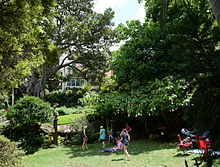Brett Whiteley
While still at school, Whiteley visited the Macquarie galleries and saw a one-man exhibition of the work of the landscape artist Lloyd Rees.
His paintings during these years were influenced by the modernist British art of the sixties – particularly the works of William Scott and Roger Hilton – and were of brownish abstract forms.
During this time, Whiteley also painted works based on the animals at the London Zoo, such as Two Indonesian giraffes, which he found sometimes difficult.
Whiteley appears as a character in the book Falling Towards England by Clive James under the name Dibbs Buckley.
The Hotel Chelsea displayed several of Whiteley's paintings from the time he lived there, including Portrait of New York which was hung behind the reception desk.
The painting which was finally produced was made of a fantastic array of elements, including collage, photography and even flashing lights, with a total length of nearly 22 metres.
[9] He took the van Gogh painting and stretched the lines of the room to a single vanishing point, creating an image which appears fast moving and extremely vibrant and dynamic.
Reading from left to right, it begins with an exploding sun from a portrait of Yukio Mishima that Whiteley had started but never completed.
The famed author Mishima had committed seppuku in 1970 and the literary mythology that arose of his apparent final vision of enlightenment in the form of the exploding sun, as he pressed the knife into his body, inspired and became the basis for this work.
In terms of media, it used everything from feathers and part of a bird's nest to a glass eye, as well as shell pieces, plugs and brain in a work that becomes a transmutation of sexual organic landscapes and mindscapes.
According to art writer Bruce James, the self-conscious inclusion of the austere pronoun 'IT' that also makes up part of the work compacts life, passion, death and faith in a single empowering word and unites the notional wings of an altarpiece to nascent addiction.
In the latter painting, the table in the front of the room close to the viewer has minutely decorated vases and small objects, while a drawing on the left and a sculpture to the extreme right show how Whiteley often used erotic images in his works.
His first Archibald award, Self portrait in the studio, in deep bluish tones, shows an image of his studio at Lavender Bay overlooking Sydney Harbour, with his own reflection in a mirror shown at the bottom of the picture; a view of Sydney Harbour on the left establishes the location of the picture.
As with other works, there is evidence of Whiteley's love for Matisse, ultramarine blue, the Sydney Harbour location and for collected objects.
[19] In 1999, Whiteley's painting The Jacaranda tree (1977), which had won the Wynne Prize, sold for A$1,982,000,[20] a record for a modern Australian painter at that time.
[21] On 7 May 2007, Opera House, (which took Whiteley a decade to paint, and which he exchanged with Qantas for a period of free air travel) sold for A$2.8 million, in Sydney.
A 1992 updated edition of the Whiteley book, with an interview with the artist that McGrath recorded in 1990 and Whiteley's own thoughts on his art,[25] then being released as a paperback two months after his death, was the subject of a 24 September hearing in the Federal court to examine whether allegedly offensive material infringed copyright as claimed by solicitors for stakeholders in the artist's estate.
[26] They also asserted that Whiteley's assent for colour reproduction of his works in the first, hardback edition would not cover the monochrome reprints in the new paperback.
[27] The publicity attracted attention, though the publisher's agent Tom Thompson challenged journalist Andrew Main to 'let us know' if he found any 'offensive' passages.
[28] Ensnared in the controversy and after the court in October 1992 ordered the withdrawal of the paperbacks,[29][30] Thompson resigned under pressure from Angus & Robertson.
Hell hath no fury...[32]McGrath started to write another, more extensive Whiteley book with interviews of his friends and associates including Bob Dylan before HarperCollins, an imprint of Angus & Robertson, withdrew their interest,[31] while others including Graeme Blundell, Blanche d'Alpuget, Frannie Hopkirk, Barry Pierce,[33] and Janice Spencer drafted or published further biographies.
It was written with unprecedented behind-the-scenes access, and illustrated with classic Brett Whiteley artworks, rare notebook sketches and candid family photographs.
On 23 November 2017 the book was named the people's choice winner at the Mark and Evette Moran NIB Literary Award.
Directed by James Bogle and produced by Sue Clothier, Whiteley includes extensive archival footage and photos, personal notes and letters, as well as animations and dramatic reconstructions, although no new interviews were shot for the film.



